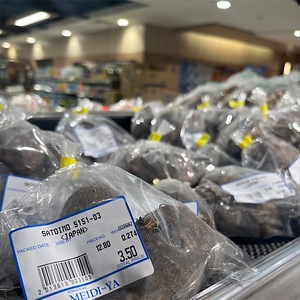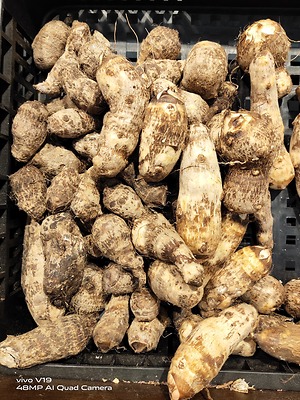


Satoimo Root (Taro)
Estimated Inventory, 10 lbs : 0
This item was last sold on : 01/04/25
Description/Taste
Satoimo has a roughly textured, earthy brown skin with fibrous hairs, similar to the texture of a coconut. The tuber is small, about the size of a fist. The more common taro has a longer rootstock with a shape similar to a sweet potato, whereas Satoimo is smaller and roughly rounded, with tapered ends. Its flesh is firm and creamy white with flecks of purple. The main component of Satoimo’s flesh is starch and it has a somewhat slimy texture, similar to that of okra. The flavor is mild with hints of nuttiness. Like other varieties of taro, Satoimo contains the toxic calcium oxalate, which act like tiny pieces of glass, irritating the mouth and throat. This irritant is removed when the tuber is cooked.
Seasons/Availability
Satoimo are available year-round.
Current Facts
Satoimo (Sa-toy-imo) is the Japanese name for the variety of taro root that grows wild and is also cultivated in Japan and in other parts of Southeast Asia. The name means “potato of the homeland.” Botanically, this variety is classified as Colocasia esculenta var. antiquorum having smaller corms, or tubers than the more common taro. It is known as Japanese sweet taro, dasheen or araimo.
Nutritional Value
The Japanese sweet taro is high in fiber and has fewer calories than the potato, yet is just as filling. It is high in potassium and is low-glycemic, making it an ideal alternative starch for diabetics. Satoimo is rich in hyaluronic acid, a substance produced naturally within our bodies in abundance when we are young. It promotes strong joints and produces natural collagen.
Applications
Satoimo is often prepared much like its starchy look-a-like, the potato. It MUST BE COOKED in order to remove the irritating calcium oxalate. When peeling Satoimo, the use of gloves can minimize any irritation to the skin from the calcium oxalate. The Japanese root can be boiled and roasted or steamed and pureed. In Japan, the small tuber is used to make noodles, often appearing in lunchtime bento boxes. Satoimo is often simmered in soy sauce, sugar and ginger (creating a sweet and salty flavor) and then added to soups and stocks. In Japanese cuisine, Satoimo is traditionally boiled in flavored dashi, or simmered for kenchin jiru, a type of hearty miso soup served with tofu and hon shimeji mushrooms. Satoimo will keep in a cool pantry for a couple of weeks, and longer wrapped in plastic in the refrigerator.
Ethnic/Cultural Info
Satoimo has been cultivated in Japan since the Joumon Period, which lasted roughly 14,000 B.C to 300 B.C., and was known as a staple food well before rice was introduced. Satoimo has been called “nature’s odd fountain of youth” due to its high amounts of hyaluronic acid, which is essential component in cell regeneration.
Geography/History
Satoimo is native to Southeast Asia, and typically grows in swampy or wet conditions. It can, however, be grown in dry conditions, and prefers hillsides and evenly moist soil. Satoimo is very common not only in Japan, but also in Vietnam, Cambodia and the Philippines. Satoimo grow easily throughout the year and without the need for much attention, resulting in a stable crop yield.
Recipe Ideas
Recipes that include Satoimo Root (Taro). One
| Just One Cookbook |
|
Satoimo no Nimono |
| The Spruce Eats |
|
Simmered Satoimo |
| Daily Cooking Quest |
|
Taro Root Tumbles |

















